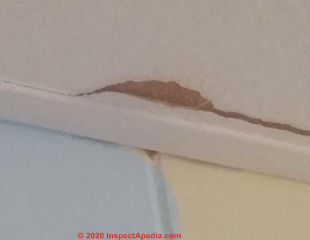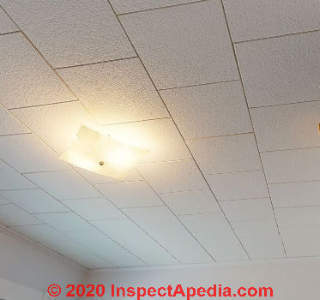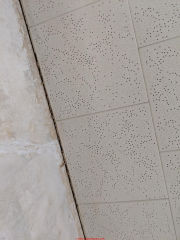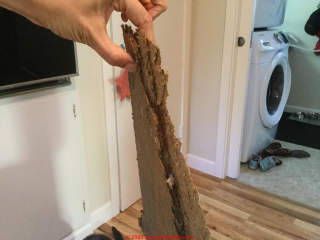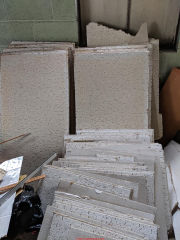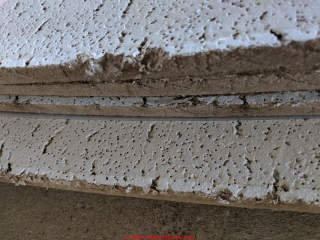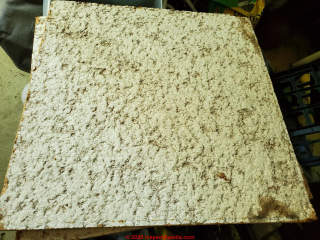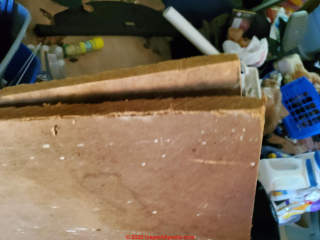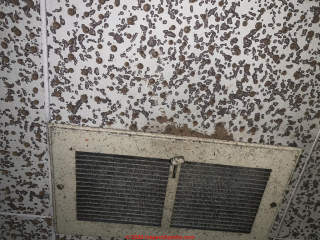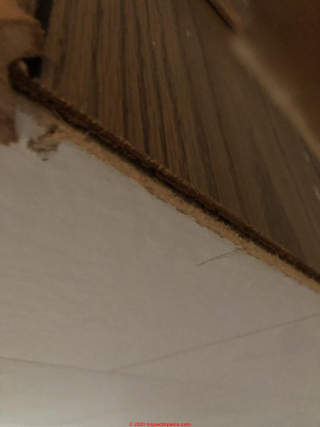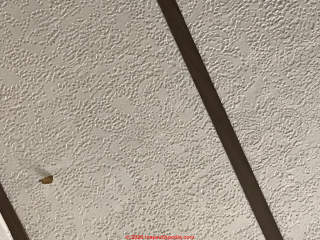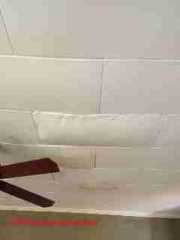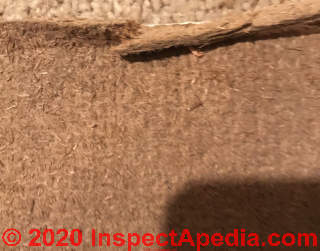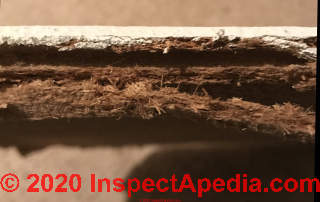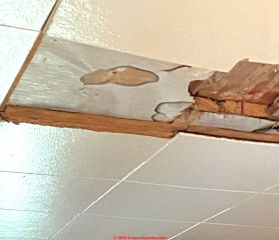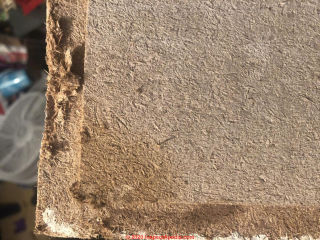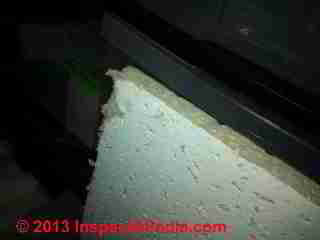 Asbestos-Ceiling Material FAQs-2
Asbestos-Ceiling Material FAQs-2
More Q&A about ceilings that may contain asbestos
- POST a QUESTION or COMMENT about how to identify & manage ceiling tiles that might contain asbestos
Asbestos-containing ceiling FAQs:
Questions & answers about how to recognize ceiling tiles or other materials that may contain asbestos.
This article series provides photographs and descriptive text of asbestos insulation and other asbestos-containing products to permit identification of definite, probable, or possible asbestos materials in buildings.
InspectAPedia tolerates no conflicts of interest. We have no relationship with advertisers, products, or services discussed at this website.
- Daniel Friedman, Publisher/Editor/Author - See WHO ARE WE?
Asbestos-containing Ceiling Tile FAQs-set#2
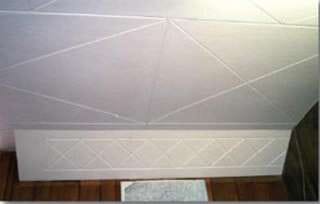
These questions & answers about ceiling tiles that do, do not, or might contain asbestos were posted originally
at ASBESTOS CEILING TILE IDENTIFICATION - be sure to read that article.
Also see DO THESE CEILING TILES CONTAIN ASBESTOS?
On 2020-12-13 - by (mod) -
I can't really see much in that photo [above] but it's possible that we're looking at fiberboard which is a wood product, not asbestos.
To make your best guess try answering the questions that you can from the procedure on the page above.
On 2020-12-13 by SG
Does this material look like asbestos? Drop ceiling installed sometime in the 1970s, (probably around 1978) in the US.
On 2020-12-13 - by (mod) -
It's possible.
Whenever I see ceiling tile material that is not clearly a brown or yellow wood or fiberglass product I'm inclined to be careful on the asbestos question.
Do let us know your test results.
That ceiling tile was probably made a few years before those manufacturers who had done do ceased using asbestos in ceiling tiles.
On 2020-12-12 by Montana
These were installed in 1985 as a false ceiling in an unfinished basement. Sending it out for testing. Does this look like probably ACM?
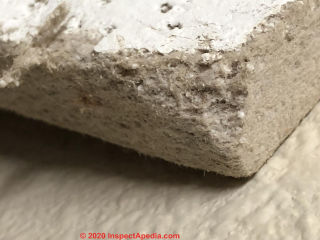
On 2020-12-10 - by (mod) -
Benjamin
I enjoy using US Patent research as a useful, if incomplete, check on whether or not products are likely to contain asbestos.
In this case your U.S. Patent No. D-168763 dates way back to
Merriman, Alanson, PUNCH PRESS [PDF] U.S. Patent No 168763 granted Oct. 11, 1875 - possibly referring to machinery used in the production of acoustic ceiling tiles.
See the patent
at
https://inspectapedia.com/hazmat/Merriman-Patent-US168763.pdf
Your photos looks like a cellulose-based or wood-fibre-based material.
The date RD-1952 would be well before people stopped using Asbestos in products in most countries but may also be irrelevant.
Your best guess at whether or not your ceiling tile contains asbestos, as you've no other identification marks, is to follow the advice and questions given in the article above, found at
DO THESE CEILING TILES CONTAIN ASBESTOS? inspectapedia.com/hazmat/Asbestos_Ceiling_Tiles.php#asbmaybe
or, of course, to have a sample tested.
On 2020-12-10 by Benjamin Hoffman
Looking to see if this ceiling tiles contains asbestos payment number D-168763
On 2020-12-08 - by (mod) -
ASBESTOS TESTING LAB LIST for access to certified asbestos testing labs
see live link just above on this page
On 2020-12-08 by Anonymous
Asbestosslab
On 2020-12-06 - by (mod) -
Looks like a wood fibre product. You'd have to know the tile age or have a sample tested for asbestos to have a completely certain answer.
On 2020-12-06 by Leana
Hi, we have two types of ceiling tile I’m worried about. I can’t find the dotted ceiling tile anywhere online so have no sense of how old it is and who manufactured it. Under it, we’ve found addition soundboard/ceiling tiles do either one look like they contain asbestos? I know it’s hard to tell from a photo, but am curious if anyone recognizes either. Thanks!
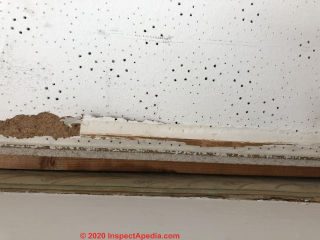
On 2020-11-22 by Sal
Thank you for your advice. Am very grateful!
On 2020-11-22 - by (mod) -
Sal
One "broken" ceiling tile is simply not likely to be a significant potential source and perhaps not even a measurable source of of harmful dust unless you somehow ran the entire tile through a macerating grinding device to make a high volume.
However if you are quite anxious about this question, that anxiety itself is a potential health hazard.
On that basis we have to suggest that you have a sample of the ceiling tile tested
and that you collect and sample and have tested representative samples of settled dust in your home.
Watch out: don't let your broken ceiling tile so capture your concern that you miss attending to far more likely hazards in your home such as fire, smoke, carbon monoxide, or falling down the stairs.
also read OTHER PEOPLE's MONEY inspectapedia.com/home_inspection/Other_Peoples_Money.php
PLEASE FIND all of our discussion now located at
ASBESTOS CEILING TILE FAQs-7 https://inspectapedia.com/hazmat/Asbestos-Ceiling-Tile-FAQs7.php
where we welcome your further comments, questions, or suggestions.
On 2020-09-09 - by (mod) -
 Kathy, as we note in the article above, according to the company, "Armstrong ceiling tiles & suspended ceilings do not and have not ever contained asbestos"
Kathy, as we note in the article above, according to the company, "Armstrong ceiling tiles & suspended ceilings do not and have not ever contained asbestos"
See details at ARMSTRONG CEILING TILES
On 2020-09-09 by Kathy
Just wondering if these Armstrong fire resistive 2x2 ceiling tiles contain asbestos. They were installed in our drop ceiling in our basement between 1977-1986.
On 2020-08-08 - by (mod) -
Nick those may be cellulose or wood fiber based ceiling tiles, but nobody can say for sure by just your photo.
On 2020-08-07 by Nick
Hello I was wondering if you could identify asbestos through a few pictures. I know it’s likely I’d have to have it tested, but I have no idea what I’m looking at and I know that’s what you do.
My house was built in like the early or late 40s I think 1942. Part of my ceiling fell in from a water leak upstairs and this was the result.
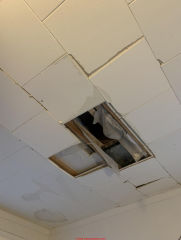
On 2020-07-16 by Carole
Property is over 40 yrs old and we have ceiling tiles. I am showing signs of asbestos poisioning. Property is 4/50 James st, Rotorua.
On 2020-07-14 - by (mod) -
If you can remove the wall board in sandals with a minimum of disturbance and avoiding creating a Dusty mess you're probably safe in any event.
On 2020-07-14 by Laura G
Yes that greenish later. It’s a thin cork veneer and then about half an inch of this dense papery stuff. Nothing rigid behind it. I guess I could try to remove it from the wall to look for labeling on the back but I didn’t want to disturb it further if it was definitely dangerous.
On 2020-07-14 - by (mod) -
Laura I'm not sure what we're checking here: that green layer of wallboard? Take a look at its back surface. It may be a fiberboard product with a thin cork veneer, and behind that a thicker particleboard.
One cannot assert the presence or absence of asbestos in the material from your photo alone, but knowing a few more details can let you make a reasonable guess.
See the 6 steps given at https://inspectapedia.com/hazmat/Asbestos_Ceiling_Tiles.php#asbmaybe - written for ceiling tiles but pertinent to other materials such as your cork-surfaced wall tiles.
On 2020-07-14 by Laura G
I was going to remove a cork wall but when I exposed the edge I unexpectedly found that it wasn’t cork all the way through. Is there asbestos in this product?
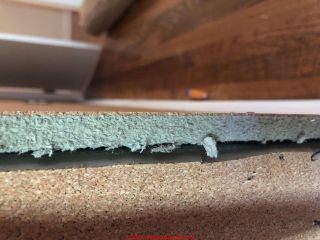
On 2020-07-11 1 by R
Do these look asbestos? Having trouble finding a local place to test them.
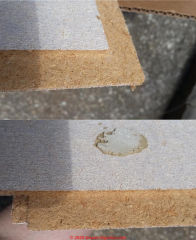
On 2020-06-09 by Richard
Do these ceiling tiles look like they contain asbestos? Not sure what I'm looking for.

On 2020-06-08 - by (mod) -
No Ja
What to know with certainty you would need to have a sample tested. If you want to be extremely cautious and safe in the meantime treat the debris is presumed to contain asbestos and clean it up accordingly
On 2020-06-08 by jahesson
This ceiling tile fell down for no particular reason. I have no idea of the date of installation, but the rowhouse itself was constructed in 1915. Do these fallen ceiling tiles look like asbestos?
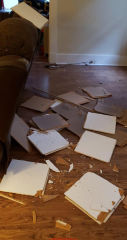
On 2020-05-25 - by (mod) - test ceiling tiles not likely to contain asbestos - reduce worry = less health risk
 Looks like a cellulose or wood fiber product.
Looks like a cellulose or wood fiber product.
Worry is its own health hazard; so for your own peace of mind you should have a sample tested.
See ASBESTOS TESTING LAB LIST for access to certified asbestos testing labs
(We have no financial, business, nor other connection with any product or service.)
Let me know what you're told. - Photos above & below.
On 2020-05-25 by Ryan
Removed ceiling tiles from older home. Disclosure and inspection indicated no asbestos but now I am paranoid about the tiles. They look like a wood based product that is relatively newer but I want to be sure. Should I get them tested?
On 2020-05-20 - by (mod) - cellulose or wood-based product but can't be certain that it contains no asbestos
Sue
That looks like a cellulose or wood-based product but I can't be certain that it contains no asbestos.
You would need to either identify the manufacturer and product or have a sample tested by a certified asbestos test lab. If you search inspectapedia. Com for asbestos test Labs you will find directories of that service
On 2020-05-20 by Sue - edge view of cellulosic ceiling tile, acoustic, perforated
The edge close up
On 2020-05-20 02:46:42.705427 by Sue
We weren't planning to remove this ceiling tile, but when removing crown molding to strip wallpaper we noticed the edges of the tile are crumbling, and chunks come off as the wallpaper is removed. It's not a dropped ceiling, just acoustic tile with small holes in it.
We have no idea when it was put in, but the room decor is 60s-80s. Does this look like asbestos tile to you?
On 2020-05-16 - by (mod) - wood fiber product which would not be asbestos
That looks like a wood fiber product which would not be asbestos but from a mere photo one cannot be certain.
With no other information our options are for you to take a look at the questions posed in the article above on this page about the probability that your ceiling tile contains asbestos, or to treat the material is presumed to contain asbestos or to have a sample tested.
On 2020-05-16 by Alisa - tongue and groove wood-fiber like ceiling tile, no date
These are tongue and groove Square ceiling tiles, no idea the date. Asbestos?
On 2020-05-14 - by (mod) - 2'x2' and 2' x 4' ceiling tiles
That looks like a paper or cellulose material, but I can't bet your health and money on a photo. I'd have a sample tested,
OR
treat the material as presumed to contain asbestos, bag it, dispose of it as construction waste (local laws vary), and then damp wipe and HEPA vac the remaining dust so as to put yourself at ease.
2ft x 4ft ceiling tiles are likely to be a more-modern drop-in suspended ceiling tile
On 2020-05-14 by Courtney
Close up of the broken tiles
We recently bought a house built in 1895, but clearly last decorated in the 60s-80s. Shortly before we moved in two drop ceilings were removed (not by us) and I'm worried about residual dust in case of asbestos, especially because we have children and the place has clearly not been cleaned at all.
The tiles are still sitting in our garage. They have no manufacturers marks on the backs
. There are two sizes 2' x 2' and 2'x4'. Do you think these are likely to contain asbestos?
On 2020-05-11 - by (mod) - brown wood-fiber-like appearance, is probably a cellulose (not asbestos) ceiling tile
Andrew
The ceiling tile, because of its brown wood-fiber-like appearance, is probably a cellulose (not asbestos) product,
but
Without a lab test or knowing the specific brand and product ID, to be careful I must say treat the ceiling as presumed to contain asbestos or have a sample tested.
On 2020-05-11 by Andrew - photo of 1960s acoustic ceiling tile, rough surface
wondering if these drop down ceiling tiles could have asbestos. I already sent away from the test kit, but wanted to feel better sooner if possible. I have lived in this space in question for 20 years and there has been a lot of work and activity which on occasion would cause damage to the tiles and break them.
This happened yesterday and scattered debris all over my desk and belongings. The house is 1960's but we are not sure when the ceiling itself was done. We have been in the house since '84. Thank you, thank you, thank you!
On 2020-05-11 by Andrew - I did not even know ceiling tiles could have asbestos
Hey, I am wondering if these ceiling tiles could possibly have asbestos. I have the test kit on the way to me, but I want to feel better if possible. I have lived in this space for years and had a lot of activity where tiles have broken open and been damaged spraying their particles.
I did not even know ceiling tiles could have asbestos so this is more than a little troubling. The house was built in the 60's and we are not sure if the drop down was part of a remodel later or not. We have owned the house since '84.
On 2020-04-20 by Alex N
It does look like a wood based product, would these be considered acoustic tiles since they have the holes in them? And we’re wood fiber acoustic tiles known to have asbestos content?
On 2020-04-20 - by (mod) - fiberboard or cellulose material ceiling tile
I don't know, Alex,
But that small area of damaged ceiling tile shows what looks like fiberboard or cellulose material. (That would be a wood fiber based product).
Asbestos in those products is possible but not common.
On 2020-04-20 by Alex N
Wonder if you these ceiling tiles contain asbestos, don’t want to mess with to see back of tile. No spares around either, house was built in late 50’s, tiles are in basement not sure when they were installed.
On 2020-04-14 - by (mod) -
Riles
See your question already posted at ASBESTOS-FREE CEILING TILES
thanks
On 2020-04-14 by Riles
Would these contain asbestos?
On 2020-02-27 - by (mod) - USG Ceiling tiles: A 0308111842 USG C0 (or possible a Q) 3 5. It also has a sticker that says Fifth Ave 280
Looks like a US Gypsum product, Keisha.
See details at US GYPSUM CEILING TILES
Also you can make a reasonable guess at the asbestos question by seeing
DO THESE CEILING TILES CONTAIN ASBESTOS?
On 2020-02-27 by Keisha
I could use some help!
I am trying to determine is the following ceiling titles have asbestos.
The number on the back are:
A 0308111842 USG C0 (or possible a Q) 3 5. It also has a sticker that says Fifth Ave 280
On 2020-02-26 - by (mod) - probable soft fiberglass, plastic-surfaced suspended ceiling tiles
Mike
With no information whatsoever I can't make a reasonable guess about asbestos in your ceiling tiles. You might know more by taking a look at the ceiling tile (these look like drop-in suspended ceiling sections) edge and back surface.
But from your **description** of soft and pliable and from seeing those strips that suggest theser are drop-in suspended ceilint tiles, I suspect the ceiling tiles are plastic-surfaced fiberglass rectangular ceiling tiles.
Please see the easy Q&A at DO THESE CEILING TILES CONTAIN ASBESTOS?
as that will let you make a reasonable guess
On 2020-02-26 by Mike
Are these asbestos ceiling tiles? Soft pliable
On 2020-02-19 - by (mod) - asbestos in 1972 ceiling tiles?
That looks to me like some type of cellulose or wood product fiberboard.
On 2020-02-19 by Wondering if this is asbestos
I tore down this ceiling without even considering that it might be asbestos. I believe the renovation of this house was done in 1972.
It is possible that the tiles were put up later but I have no idea. I am barely a DIY. Can you determine if this is something I need to be concerned about?
On 2020-02-16 by (mod) -
Mr. Lee
Your photos and our discussion of possible asbestos in Malaysian ceiling tiles are now found at MALAYSIAN CEILING TILES
We welcome further questions or comments or photos.
Question: do these suspended ceiling tiles contain asbestos?
 Was wondering if you could tell if these are likely asbestos ceiling tiles? The building was made in 1985 though I don't know the age of the tiles. They say "CON SAFE" on the back... They are in my workplace, a government building. - B.B.
Was wondering if you could tell if these are likely asbestos ceiling tiles? The building was made in 1985 though I don't know the age of the tiles. They say "CON SAFE" on the back... They are in my workplace, a government building. - B.B.
Reply:
B.B.
While the current 1999 EPA notice basically retracted asbestos bans in the U.S., as we noted in the introduction to this article, because of consumer resistance to purchasing asbestos-containing material (ACM) for housing or office finish products, it's not likely that an office put up in 1985 used ACM.
Unfortunately, a responsible and reliable reply is that one can't know for sure when a material was made nor what it contains simply from your photo - you'd need to have a little sample of the material tested by a certified asbestos testing lab for a definitive answer.
Question: is cleaning up dust after improper asbestos removal dangerous
How dangerous is it to clean up an area after asbestos tiles were removed without proper equipment or disposal? What is required to be safe during clean-up? - Darlene 1/21/2013
Reply: quite possibly
Darlene: in my OPINION the answer is at least potentially YES.
If asbestos containing material, particularly friable materials such as ceiling tiles, or any ACM that was removed in a manner that created dust was removed without proper dust containment and follow-up testing, there could be high enough levels of asbestos in remaining dust in the building to be a hazard to occupants.
For example, running an ordinary household (non-HEPA) vacuum cleaner, or even a HEPA rated vacuum if it leaks, would send that asbestos-containing dust into the air - where occupants may indeed breathe it.
In my own experience I've encountered this problem a number of times and often follow-up testing confirmed that further professional cleaning was needed.
Provided that there is an established need (and thus justification of the expense) for an asbestos dust cleanup, a professional will set up dust containment to keep other building areas safe from dust, use a negative air machine as part of that containment, then typically s/he will HEPA vacuum and damp wipe the building surfaces.
A follow-up test by a professional confirms that the cleanup was successful and that the containment system also worked.
Question: do these 16x32" ceiling tiles in a 1941 home contain asbestos?
We are buying a house built in 1941 that has 16"x32" ceiling panels glued to the rafters in every room (photo attached).
Leaks from the roof have damaged many of them and we need to know whether they contain asbestos before we disturb the area. Are asbestos testing kits from a hardware store a legitimate way to go? - C.H. 4/18/2013
Reply:
Dear C.H.
No one should pretend that they could reliably identify or exclude asbestos-containing material in your building or its ceiling from just your photo, but I certainly understand and appreciate the question.
There are certainly ceiling tiles that do contain asbestos, and others even of the same era (up to the 80's) that do not. Sometimes one can look at the material by eye and see that it is a wood fiber product; but if you don't know, leave it alone until you do.
From the dimensions you gave and from your photo, I'm not 100% sure you are looking at acoustic ceiling tiles, though I agree that the beveled edges in a closer look at your picture look like glue-up or staple-up ceiling tiles not plaster. For comparison
As you suspect possible asbestos I suggest:
- First: do not make a dusty mess and don't perform demolition nor run vacuum cleaners (unless HEPA rated) before you know what materials are present
- Second: as demolition is required, you might want to contact a certified asbestos testing laboratory for sample collection advice and processing - typically it's a $50. or less cost.
I can't comment on an over-the-counter asbestos test kit - as honestly I just don't know what you were looking-at. Identification of asbestos dust or fibers in materials requires two kinds of microscopic examination; if the test kit is simply a container for a sample, along with safe sampling instructions, and that material is sent to a certified lab, perhaps that's fine.
At ASBESTOS TESTING LAB LIST we provide information on how to find a qualified, certified asbestos testing laboratory.
If there is access to the ceiling from above and if you can safely enter there and safely lift insulation for inspection, check, to see if those bulged or pillowed segments of the ceiling are visible from their upper side as plasterboard. [If you find vermiculite ceiling in the area don't disturb it because that may be an asbestos hazard even if the ceiling proves not to be.
Vermiculite building insulation was often poured into previously un-insulated ceilings of homes from the 1940's. Some vermiculite contains asbestos.
See details at VERMICULITE INSULATION
Keep us posted if you have the material tested or if you are able to explore the extent of water-related damage above this ceiling - what you find will assist other readers.
Question: Do You Think These Ceiling Tiles Contain Asbestos ? [photo attached]
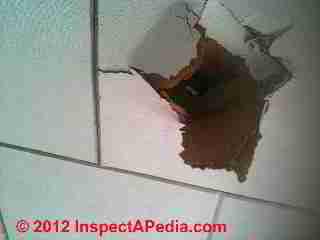
Do you think this contains asbestos? - Anonymous
Reply:
Your photos show what look like 9-inch or possibly 12-inch brown fiberboard acoustic ceiling tiles. While the predominant material in these ceilings is usually wood fibers, indeed up to the 1980's many such ceilings contained asbestos as well.
A competent onsite inspection by an expert usually finds additional clues that help accurately find where there are asbestos containing materials (ACM), presumed-asbestos containing materials (PACM), or what might also be called "asbestos-suspect materials".
That said, here are some things to consider:
For safety it makes sense to treat presumed-asbestos materials or PACM as if they indeed contained asbestos, meaning apply the same guidelines: leave intact materials alone if possible, encapsulate the material for added protection, and if materials are damaged, friable, or are likely to be disturbed by normal building activities, bring in a professional asbestos abatement contractor who, after confirming that the materials are asbestos-containing, will handle the removal or encapsulation with professional dust control, removal, cleaning.
For a single damaged ceiling tile such as in your photo, I'm doubtful that calling a professional asbestos abatement company will be justified, but if you treat the material as Presumed Asbestos Containing Material (PACM) that means using appropriate methods for cleanup and then encapsulation or covering of the damaged section.
Question: Do you think this Canadian acoustic ceiling tile is an asbestos material? I have chest pains since taking down this dusty mess.
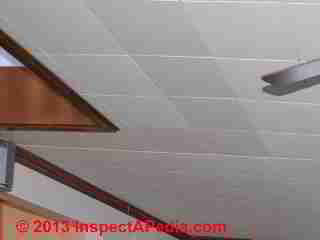 Hi i think these were installed in the mid 80's or even 90's. They are really dusty when removed them.
Hi i think these were installed in the mid 80's or even 90's. They are really dusty when removed them.
I removed them all about a month ago, sometimes i have some breathing chest mild problems but i think from painting and general reno dust. Are you familiar with these tiles in Ontario? - M. 11/28/12
Reply:
The tiles in your ceiling by dimension and general appearance could contain asbestos;
In my OPINION, even if the tiles didn't contain asbestos, exposing yourself to a high dose of dust can easily result in respiratory irritation and on occasion other health issues from rodent, insect, or other particles.
If you never checked with your doctor you should do so. I'd do that even before testing the material for asbestos.
Question: can we paint our asbestos-suspect ceiling tiles or do they have to be covered over?
We have square ceiling tiles in living room and bedroom that were probably installed in the 60's or 70's. The ceiling has been painted with a latex-type paint.
There are no friable areas, everything seems intact and covered with a layer of paint. Does this painting effectively prevent presumed asbestos fibers in the tiles (based on age) from entering the air and creating a hazard? Or should the ceilings be furred out and covered? - Edward, 12/3/2012
Reply:
If the ceiling is painted, not friable, not damaged, not in an area likely to be damaged, it's best to leave it alone. You don't need to install a new ceiling layer over it.
Additional asbestos-in-ceiling tiles questions and replies are in the FAQs section of this article.
Question: do you think these ceiling tiles contain asbestos
2019/12/28 Anonymous asked:
There was some dusting when drilling and removing the tiles (pictures attached) but they seem layered and feel like bunch of sheets of thick brown paper stuck together.
Upon closer inspection, I do see the boards are made of bunch fo fibers. The house was built in the late ‘30s but I am not sure when the ceiling tiles were installed.
What’s your opinion on this? - by private email
Reply: Asbestos is unlikely as this looks like a cellulose (wood fibre) product.
Nobody is going to bet your health and safety on simply an e-text and some photos, but what I can see looks like a wood fiber type ceiling product.
You'd have to either know more (country, city ceiling tile age (probably newer than your 1930's building), and any manufacturer identification markings) - OR you'd need to have a sample tested.
Information you may also want to see is at SHEATHING, FIBERBOARD ASBESTOS CONTENT
Reader follow-up: the ceilingtiles shown here do not contain asbestos
Thanks for getting back to me. I did take a sample and send it in for testing.
I also got in touch with one of the previous owners who said she lived here (Denver) from 1985-1990 and she said the basement wasn’t finished then so I won’t know for sure until I get the lab results back but I think you’re right that they are just wooden fiber boards. I will keep you posted. - Anon
Moderator reply:
That's encouraging since 1985 is getting rather near the end of asbestos in such products in the U.S.
Reader Follow-up: 95% cellulose, 5% non-fibrous material.
Came back negative. 95% cellulose, 5% non-fibrous material. You were correct. Thanks.
Question:
2019/09/15 Lu Ka
Hello. Do you think those tiles contain asbestos? I have no info about them.
There was a water leak from the second floor bathroom through the tiles recently and they have been moved by the water as you can see in the picture. I was there when that happened. Do you think I may have been affected?
Reply:
Ka
I don't know what happened to your photo, perhaps I accidentally deleted it; I'd be grateful if you'd post it again.
Most likely we can't say from a photo alone whether or not a ceiling tile contains asbestos unless we know more such as the manufacturer, product identification, country, city, building age, ceiling age; Help in making a reasonable guess at an answer to your question about the asbestos probability is in the article above.
No one with any sense will claim that they can know whether or not you've been somehow affected by a ceiling based on a brief e-text.
However if there is asbestos suspect material AND if a dusty mess was made during demolition or repairs such that dust was distributed into occupied space, then additional cleanup and perhaps testing would be in order.
On 2020-12-08 - by (mod) -
For a best answer please see: DO THESE CEILING TILES CONTAIN ASBESTOS?
On 2020-12-08 byTrent
But would that type of tile contain asbestos?
On 2020-12-08 - by (mod) -
That sure looks like an acoustic ceiling tile, not plaster - typically made of cellulose fibres.
If you can post a photo showing the material edge and back we can be more-confident.
On 2020-12-07 by Trent
Looks like plaster but tiles look like they could of been pre 1990s
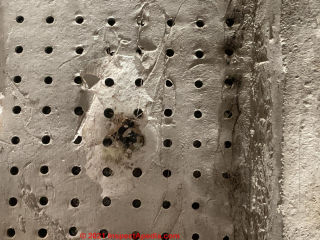
On 2020-06-19 - by (mod) -
No, Mariah
but for an unequivocal answer you'd need to have a sample tested.
On 2020-06-19 by Mariah
Does this look like an asbestos ceiling tile? [Photo above]
On 2020-05-29 - by (mod) -
Mrs
That's probably a cellulosic - or wood- based ceiling tile; but if you want to be safest, have a sample tested (cost is about $50.) - and if you do that, let me know what you're told.
On 2020-05-29 by Mrs. W
My husband purchased our old home in 1986 and these tiles were in one of the bedrooms that we have closed off and use for storage. I would like to clean the room out and remodel but I’m afraid not knowing if they contain asbestos. The tiles are smooth and tongue and groove.
On 2020-04-03 - by (mod) -
Looks like a cellulose-based fiberboard product to me.
See details at DO THESE CEILING TILES CONTAIN ASBESTOS? https://inspectapedia.com/hazmat/Asbestos_Ceiling_Tiles.php#asbmaybe
On 2020-04-03 by Mr. T
Is this asbestos?
On 2018-05-25 by (mod) - interlocking square ceiling tiles fell from attic: asbestos?
Becky
At your other post we suggested that if you can get a reasonable guess at the age of the material or the home (and the country and city) you can rule asbestos out after say the early 1980's.
See CELOTEX ASBESTOS PRODUCTS https://inspectapedia.com/hazmat/Celotex_Asbestos_Products_List.php
On 2018-05-25 by Becky in KY
Fell partially from attic through insulation and ceiling interlocking squares, which does not have anything written on the back. I know they were installed approximately 1970, but don't know the exact year for sure.
There was a box of extras in the attic kept with this info:
Celotex 260 Mayfair Washable Finish, Made at Marrero, LA Plant, 12x12, T&G Joint.
I have had a very sore throat and not felt so great since the accident which is probably incidental.
But as I was trying to figure out how to repair the ceiling by searching on the internet, I found that many materials had asbestos in them. Now I am afraid to touch it without finding out for sure. Do you know without me having to send to the lab to check? I cannot find ANY information as to whether these tiles have asbestos in them or not. Can you tell me please? Thank you so much!!!
IMAGE LOST by older version of Comments code - now fixed. Please re-post the image if you can. Sorry. Mod.
On 2018-01-14 by (mod) - ceiling tiles without any identifying label or stamp
Mich
Yes it's often the case that there is no identifying stamp; all we have left is the ceiling tile pattern and information about the building age and about estimates of when the ceiling was installed, and of course the physical appearance of the material: some ceiling tiles made of fiberglass are unmistakeable and are not an asbestos product.
On 2018-01-13 by MichiganDude
I can't find any information any where
On 2018-01-05 by Anonymous
Sorry, i cannot guess. Look for a manufacturer's stamp and note the ceil8ng age as helpful clues.
On 2018-01-04 by Michigandude
This the ceiling tile from basement. It is 16 by 16. It has white surface and white on the side. Which brand is this? Does it contain asbestos?
On 2017-03-06 by (mod) - Reader reports pleural mesothelioma after cutting ceiling tiles on table saw
Jim:
Thank you for that information, though it's of course sad and bad news for which you have my sympathy. Cutting ceiling tiles on a table saw indeed is likely to create a lot of airborne dust, still more hazardous if you didn't wear a HEPA -rated mask.
Even though the relationship between anecdotal reports of exposure and the development of mesothelioma decades later is a difficult one (because other factors and exposures are involved), the case you cite is worth noting by other readers as a warning to always use proper methods for material cutting and for dust control and for personal protection.
Back in the 70's many of us worked with dusty and hazardous materials without taking the risk seriously-enough. Signs of pleural mesothelioma may not appear until 2-5 decades after acute exposure to high levels of asbestos-containing dust. And even then symptoms may develop so slowly as to pass recognitiion for a time.
If you have more memories of the nature of your exposure and what protective steps you did not but could have taken, that might help other readers to stay out of trouble in the future.
Thank you for the comments, Jim.
On 2017-03-06 by Jim Alexander
I installed JM 12"X12" ceiling tile in my basement in 1974. I cut the tiles to fit in the area using my Rockwell table saw. I was recently diagnosed with PLUERA Mesothelioma.
On 2017-02-17 by Dingo
Were the 16" by 32" ceiling panels from the 1941 home ever tested? If so, what were the findings, I have similar panels in the basement of my grandparent's home.
On 2017-01-16 by Rim Consultancy
Is this for Pharma plan? Is it Particle shreding? Will it absorb moisture?
On 2016-12-26 by (mod)
If the ceiling is from the 60's there's a reasonable chance that it contains asbestos. Search InspectApedia for ASBESTOS TEST LAB to find a list of certified, qualified asbestos test labs - since if there's a dusty mess to clean-up and if there is no asbestos, the job cost will be significantly less.
On 2016-12-25 by Gerry
12" x12" stapled ceiling tiles put up in '60's have fallen down in mother-in-laws house. Only maring on tiles is. Swanboard ansd "made in Sweden". Any thoughts on possible asbestos content likelihood.? I have found no information at all re: Swanboard.. Should I have it tested first?
On 2016-12-23 by (mod) - stains don't cause "asbestos" but loose ceiling debris might be a hazard
Well stains don't cause asbestos but it sounds as if you're talking about cats and the landlord answers "No soap, radio" - which makes no sense whatsoever.
First, if the ceiling is not falling, damaged, fraying, releasing debris, the safest course is to leave it alone.
If the leaks are fixed, a landlord with any sense will paint stains with BIN or another lacquer primer sealer, then repaint the ceiling.
IF the ceiling is falling down or needs to be removed, then IF it contains asbestos there is a potential hazard and the removal needs to be done by a qualified removal company AFTER a test sample confirms that the material contains asbestos.
On 2016-12-23 by Nicole
Hi I live in an apartment building and I believe we may have asbestos in our hallway ceiling tiles. My landlord has been NO help. He claims the stains on the tiles are from a leaky roof that he's recently had fixed.
Is there anyway I can tell ? Thanks!
On 2016-12-13 by Anonymous
Probably around 73%
On 2016-12-13 by svlatitudes@aol.com
I am looking at an older home with accoustic ceiling tile, they are 1 foot squares that interlock on 2 sides, they are stapled to the old ceiling on 2 sides. I believe they were installed in the late 60's or early 70s. What are the chances of these containing asbestos?
On 2016-10-06 by pat - foam ceiling tiles are not asbestos
Hi , we purchased a 1977 home with an acoustic cieling on one half of the basement and acoustic cieling tiles (I think) on the other half. I have pictures. The tiles are foam, with a very thin layer of acoustic 'paper' -- it's that thin. I can't find any wording on them but they've been moved around over the last few months to run cables to bedrooms above, etc. Now I am nervous!
Tiles may be 2x4 , but sizes all vary as they were cut to fit. The acoustic ceiling (over drywall) is essentially untouched but a small hole where the owner hung a light from. I am in New Jersey. Any guidance would be greatly appreciated.
On 2016-09-03 by Anonymous
John Moore: regarding the ceiling composition, I agree that an asbestos-containing fire-resistant coating is more-likely to have been applied to a ceiling surface, but given the enormous variety of training, skill, experience among people who might be asked to cover ceilings and walls around a boiler, just about anything is possible.
You cannot completely eliminate your asbestos suspicion without a near-complete demolition of the ceiling - something I can't recommend with so little information, but an expert ought to be able to collect test samples from one or a very few strategic locations that could be examined by a certified asbestos test lab (search InspectApedia.com for ASBESTOS TEST LABS to find one).
On 2016-09-02 by (mod)
John,
I had to delete your links as the blazing blinking advertisements were really annoying.
About the ceiling tiles, it looks from your photos as if we're seeing a cellulose product ceiling tile but of course to know for sure if there is asbsestos in the material you'd need to either know the name of the product or to have a test performed by a certified asbestos test lab.
As this is a suspended ceiling it ought to be possible to remove it without creating a hazardous dusty mess in any event.
On 2016-09-02 by (mod)
Jim C said:
I live in a house that was built in 1915. There is one room that had wood paneling and a drop ceiling put in at one point with 2'x4' ceiling pieces. I am planning on removing the drop ceiling but wanted an opinion before I remove them. I have links to a picture of a hole that was drilled into it previously and the top of one of the panels
On 2016-08-30 by (mod) - unlikely to find asbestos-containing ceiling tiles covered over by wood-lath and plaster
No, John, it would be un-common (but certainly not impossible) for someone to have installed wood lath and plaster over a previousl layer of asbestos-containing ceiling tiles. The history of use of building materials argues against that sequence.
On 2016-08-30 by JohnMoore plaster ceilings with asbestos tile above?
we have a 3 layer plaster and lath ceiling that was above an old gravity fed octopus. Built in 1920 or 1922. They wouldn't have put any asbestos tiles or any other asbestos product ABOVE the plaster & lathe, would they?I'm also assuming that there wouldn't have been any loose fill asbestos insulation stuffed between the floor joists above the ceiling either. Is this assumption correct based on the year?
Is it possible to eliminate the suspicion of asbestos in the plaster layers based on the year?
On 2016-07-30 by (mod)
Al: depending on the brand and product, chances range from very likely to not at all likely.
On 2016-07-28 by Al
What are the chances of tiles in a drop ceiling of a home built in the 1950s having asbestos?
On 2016-06-07 1 by (mod)
Chances are pretty good - unless the ceiling sections are pure cellulose.
On 2016-06-07 by pattyO
in a school built in the early to mid 50s in the midwest,what are the chances of asbestos being in the ceiling tiles? I am certain that the typical green tiles used on the floor contain asbestos. It is the same color of tiles that you see in every school built back in that era.
THANK YOU IN ADVANCE.
On 2016-06-05 by (mod)
Age, appearance, can suggest that the ceiling tiles might contain asbestos, as you'll read in this article series. Actions range from doing nothing, covering-over, or if you have to do a demolition, testing for asbestos as finding it means more care needs to be taken.
Testing costs about $50. U.S. - use a certified asbestos test lab, search InspectApedia for ASBESTOS TESTING LAB to find an official govt. listing
On 2016-06-05 by Anonymous
How do I know that my ceiling tiles might contain asbestos and what do you suggest to at a minimal cost?
On 2016-06-01 by (mod)
Sure, just ask USA directly. U.
S. Gypsum Corp.
On 2016-05-31 by Sam
Hi! We received ceiling tiles for our basement (from and office building built in 1984) the number on the back is USG NFII D070496 0045. C070596 0846.
Because the actual office building was built so late we didn't think it would be an issue but is there any way to track these numbers?
On 2016-03-31 by (mod)
Well that very white interior of the acoustic tile used at what looks like a shooting range makes it suspicious I agree. You'd need a lab test to know for sure if it's asbestos. Search InspectAPedia.com for ASBESTOS TEST LABS for a list if you want to do that - typically labs charge about $40. Keep me posted.
On 2016-03-31 by (mod)
Pete said:
Does this look like asbestos containing acoustic tile?
[link deleted]
On 2016-02-01 by gradjansky@gmail.com
I am about to remove a drop ceiling of 24 x 32 accoustical tiles. On the back of one of them is the following i.d.: RADR A082602 CQ3. Can you tell me whether that helps to identify whether they may have asbestos in them? Thanks.
On 2016-01-31 by Seth
Recently decided to rewire. The basement has old ceiling tiles that I'm concerned about. They are interlocking and stapled to furrowing strips. They are 12" x 12" and about half an inch thick. Smooth surface. House was built in the 40s but I do not believe these are original. They are completely unmarked. Any ideas? Thank you
On 2016-01-24 by Anonymous
Thanks for your help
On 2016-01-24 by (mod)
Sorry no, this is not a brand I recognize.
On 2016-01-19 by Victoria
Thanks. We went through the website but don't see any specific reference for Twintex type E-Z, etc. Do you have any information about whether this specific tile contains asbestos?
Many thanks
On 2016-01-19 by (mod)
Vic. Near the start of this article or by searching inspectapedia.com foe CELOTEX ASBESTOS PRODUCTS you will find more specific information
On 2016-01-18 by Victoria
We found a box of the ceiling tiles that are in a house we are going to remodel and are wondering if they contain asbestos.
Do you know anything about the contents of tiles made by Celotex Twintex Type E-Z M-250 Almond White 12x24 Designer modified 3842. Colored designer ceiling. #640 18 2
Many thanks!
On 2016-01-17 by Bill
We are removing some 12"x24" ceiling tile
The first room that we did had tiles that were clearly marked as 2012 however when we started pulling down the tiles in the second room we noticed that they are different.
There are no marks or identifiers anywhere on the tiles except M-CL-1 or M-CL-I not sure which
This building was built in the 1930's but it had renovations done to it in the 1980's, 1990's and 2000's
The building owner claims that they are all less then 10 years old, but he cannot supply us with any proof of this
Any information would be helpful
Thanks
On 2016-01-04 by (mod)
John I can't guess from just the information you provided. If the ceiling tiles are older than the mid 1980's, depending on their composition they might contain asbestos. If it's worth $50. to know, search InspectApedia.com
for ASBESTOS TESTING LAB LIST to see some suggestions
On 2016-01-03 by john
we have demo a walmart ceiling tiles and i want to know if the tiles were asbestos
On 2015-12-19 by (mod)
Joshua,
One cannot assess an environmental hazard exposure risk from a brief etext, but if you didn't make a dusty mess I suspect that the risk was small.
On 2015-12-17 by Joshua
So the other day idk what dawned on me to do it but i had to cut a few tiles to fit them into place but they were really old ceiling tiles that contained asbestos i did it in my baisment not thinking i cut about 4 or 5 i dont know what to do am i in big danger ?
On 2015-12-04 by (mod)
Leslie, the Sta-Lite cellulose ceiling tile photo that you posted is self-described as a 12" x 24" painted-bevel cellulose product #40-004 - that's wood fibers not asbestos. The image you contributed will be added here to assist other readers. Thank you.
I'd be grateful if you'd take another look at the box for any other labels or markings.
Cellulose is not asbestos but there were asbestos warnings for workers at several Nuwood processing mills.
A detailed, illustrated and referenced reply to your question is posted now at
https://inspectapedia.com/hazmat/Asbestos_Ceiling_Tile_FAQs.php
On 2015-12-04 by (mod)
RE-posting from 2015/11/30
I've been poking around the net trying to find out about tiles in a 1960 Maine lake house that fortunately still has the box in the attic Nu-Wood Stay-Lite cellulose fiber ceiling tiles 40-004 class d: ...
...
Continue reading at DO THESE CEILING TILES CONTAIN ASBESTOS? or see ASBESTOS TESTING LAB LIST for access to certified asbestos testing labs, or select a topic from the closely-related articles below, or see the complete ARTICLE INDEX.
Or see ASBESTOS CEILING TILE FAQs-3 - more-recently posted pictures and questions about asbestos-suspect ceiling tiles
Or see these
Recommended Articles
- ASBESTOS CEILING TILE IDENTIFICATION - 5 Easy Steps to tell if CEILING TILES are likely to contain asbestos
- ASBESTOS-FREE CEILING TILES
- ASBESTOS-SUSPECT CEILING COVEROVER
- ASBESTOS TESTING LAB LIST - certified asbestos testing labs
- DOES THIS MATERIAL CONTAIN ASBESTOS? - 5 easy questions to tell if a BUILDING MATERIAL probably contains asbestos -
- HAZARD vs RISK - what's the difference, why you should care
Suggested citation for this web page
ASBESTOS CEILING TILE FAQs-2 at InspectApedia.com - online encyclopedia of building & environmental inspection, testing, diagnosis, repair, & problem prevention advice.
Or see this
INDEX to RELATED ARTICLES: ARTICLE INDEX to ASBESTOS HAZARDS
Or use the SEARCH BOX found below to Ask a Question or Search InspectApedia
Ask a Question or Search InspectApedia
Try the search box just below, or if you prefer, post a question or comment in the Comments box below and we will respond promptly.
Search the InspectApedia website
Note: appearance of your Comment below may be delayed: if your comment contains an image, photograph, web link, or text that looks to the software as if it might be a web link, your posting will appear after it has been approved by a moderator. Apologies for the delay.
Only one image can be added per comment but you can post as many comments, and therefore images, as you like.
You will not receive a notification when a response to your question has been posted.
Please bookmark this page to make it easy for you to check back for our response.
IF above you see "Comment Form is loading comments..." then COMMENT BOX - countable.ca / bawkbox.com IS NOT WORKING.
In any case you are welcome to send an email directly to us at InspectApedia.com at editor@inspectApedia.com
We'll reply to you directly. Please help us help you by noting, in your email, the URL of the InspectApedia page where you wanted to comment.
Citations & References
In addition to any citations in the article above, a full list is available on request.
- In addition to citations & references found in this article, see the research citations given at the end of the related articles found at our suggested
CONTINUE READING or RECOMMENDED ARTICLES.
- Carson, Dunlop & Associates Ltd., 120 Carlton Street Suite 407, Toronto ON M5A 4K2. Tel: (416) 964-9415 1-800-268-7070 Email: info@carsondunlop.com. Alan Carson is a past president of ASHI, the American Society of Home Inspectors.
Thanks to Alan Carson and Bob Dunlop, for permission for InspectAPedia to use text excerpts from The HOME REFERENCE BOOK - the Encyclopedia of Homes and to use illustrations from The ILLUSTRATED HOME .
Carson Dunlop Associates provides extensive home inspection education and report writing material. In gratitude we provide links to tsome Carson Dunlop Associates products and services.


